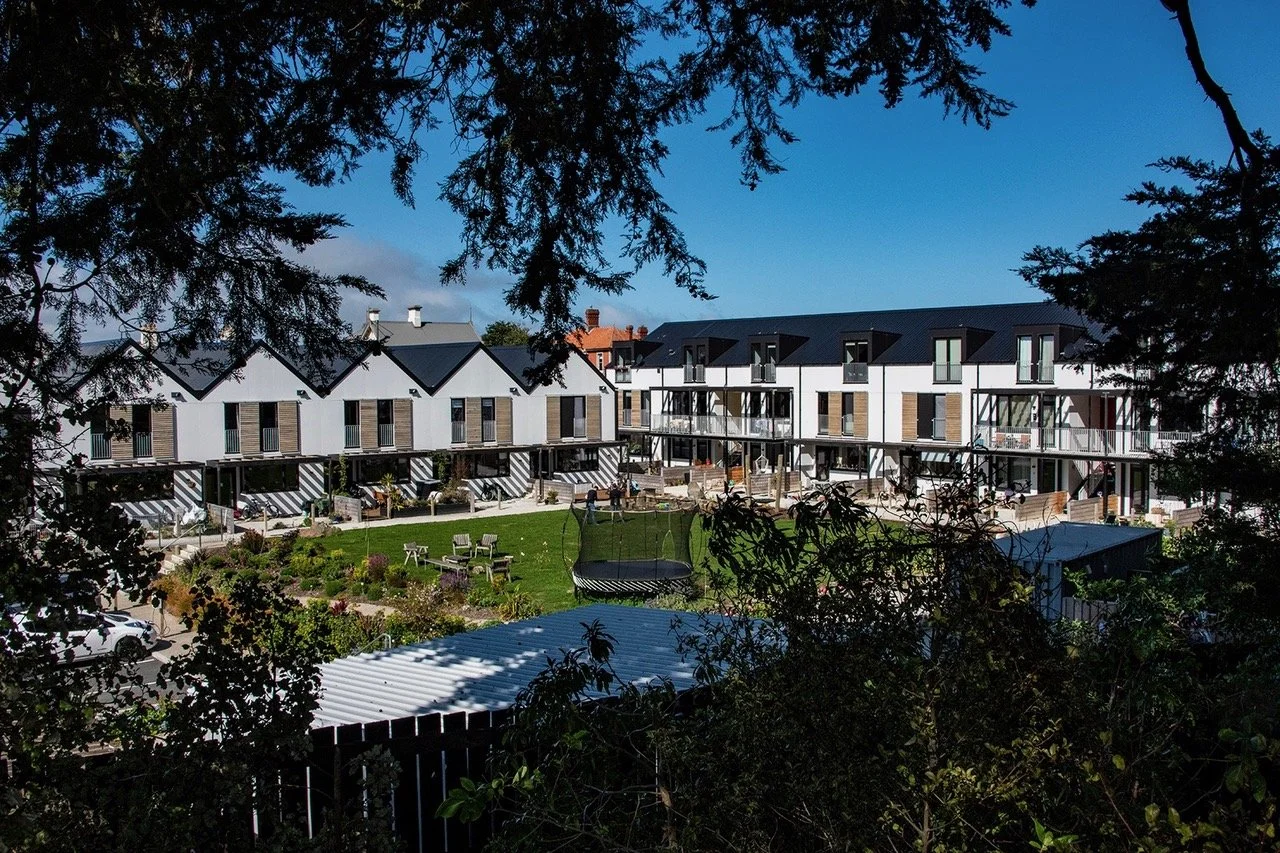Toiora Cohousing
Location
Dunedin, Otago
Stage
Established
Date Initiated
July 2013
Date Completed
July 2021
Housing Type
Cohousing
Number of Residents
41 adults, 12 children
Number of Dwellings
24
Size of Land
4,930 m2
Developed By
Self-developed through a company, shareholders becoming unit owners
Legal Ownership Structure
Unit Title
Individual Dwelling Tenure
Unit Title
Funding Model/s for Development
Owner equity, commercial loan, private loans, with each unit holder loaning 20% stake together with the company needing 36% before proceeding. Loans, not deposits, were made to the company, and therefore could be used for build purposes and GST paid at end of build, not the beginning
Housing Type and Numbers
24 Terraced houses; certified passive house standard; 2-3 floors, mostly vertical living except 1 & 2 bed units; 1,2,3,4, and 5 bed configurations
Shared Facilities
Grounds/courtyard/gardens/reduced on-site parking, (EV chargers paid for by EV group); Common House, incl. small commercial kitchen; multi-use room for dining, gatherings; meeting/craft room; office; guest accommodation (2xbedrooms & shared bathroom, accommodating 5 people maximum); workshop; laundry; garden shed; bike shed
Total Cost in Year Completed
c. $12,000,000
Governance Model
Consensus, using coloured card group decision making process
What were the external barriers experienced during development?
Finance, only 1 bank prepared to work with us; requirement for 100% sales before any building could start; high interest rates (commercial); and at settlement retail bank requirements to strip all legal documents of reference to and safe guarding of cohousing principles; council approvals; developing robust legal documents and inflexibility of legal structures given the lack of cohousing model; changes in unit titles act; lack of appropriate legal vehicle to achieve cohousing – not-for-profit company not recognised in NZ, therefore difficulties with achieving equitable outcomes regarding tax structures etc; trust and other structures not able to limit liabilities; building costs; Covid; costly mistakes made by some professionals, who were unwilling to acknowledge culpability; changes in build regulations during design/build phase; public and professional ignorance of cohousing principles, resulting for example in delays at Resource Consent due to neighbours misapprehension etc.; covenanted heritage structures on property and requirements for archaeological reports despite unpromising site; resistance to innovation – legal, council, banks and insurance; time taken to realise development – costs; changing political landscape – this meant no social housing provider could enable any form of social housing to be part of project, yet by project’s end, this might have been possible, given the huge change in the local housing market and active participation of providers in current local market. Huge amounts of time and energy were used in exploring such options.
What were the internal challenges during development?
Finding enough people; conflict around a key decision during construction; generally the coloured card consensus decision-making model worked well and achieved solution-driven discussions and decisions; recognition of work undertaken by key group members ; time taken to realise development – huge personal tolls; balancing external demands with personal needs – eg selling houses and renting in order to access finance; the tension between the need for strong visionary people and good communication and conflict resolution processes; change of circumstances for individuals over time.
If you had your time again, would you do anything differently?
Ensure a paid co-ordinator/team is valued and supported throughout the project – paid development/project co-ordinators, preferably familiar with cohousing ethos and coloured card system. Know beforehand if any social equity schemes are in operation in your area or other funding models to make it easier for younger people and families to participate.
What advice would you give to aspiring projects starting out?
Use the coloured card consensus decision making process; ensure group processes including conflict resolution are practised; choose your professionals very carefully and especially legal, who are interested in working outside the square to achieve your vision; be clear in your vision and ensure all residents are included in its development, or understand and support it, if they arrive later; be creative and have fun. Have a specifically appointed person at the Council, in order to navigate the council systems and departments; ensure start-up residents are somewhat risk-tolerant; angel investors were very important; do your research and be realistic about the personal and financial costs and then stay the course! Develop exit strategies. Be prepared to be flexible, adaptable and be able to let certain things go. Understand that the project is about relationships and the community not the buildings or individuality…
Further Information and Contacts
https://highstreetcohousing.nz/ ; ucoldunedin@gmail.com ; bodycorp@mail.toiora.nz
Can People Contact You Directly to Ask Questions?
Yes – ucoldunedin@gmail.com Catherine: 03 4536043 Anne 027 4675488


